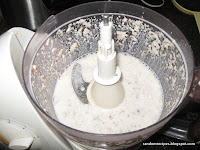 Serves 1-2
Serves 1-2Ingredients:
4 tblsp flour (plain or part wholewheat)
4 tblsp sugar
1 tblsp cocoa powder
3 tblsp milk (any kind - we use almond or coconut)
3 tblsp oil (any kind - we use olive)
3 tblsp dark chocolate chips
few drops vanilla essence or extract
Method:
Use a 15ml measuring tablespoon, with each ingredient flat rather than heaped.
Place the dry ingredients in a mug, which should be a good sized one, holding about 240-250mls (a little over an American cup). Stir in the oil and milk carefully, then gently mix in the chocolate chips and the vanilla essence.
Put the mug in the microwave, and cook for 3 minutes at 1000 watts, or four minutes at 700 watts.
This doesn't rise much, but it should have grown a little. It will be very hot. You can wait till it cools down a little and eat it directly from the mug, if you don't want to serve it in a bowl (or two) but BEWARE of the molten chocolate chips.
- - - - - - - - - - - - - - - - - - - - - - - - - - - - - - - - - - - - - - - -
The first time we tried this recipe, we were rather cynical. What, we wondered, would make it rise? Wouldn't it just be a solid lump, kind of like clay, with these ingredients?
I wondered if I had made a mistake when jotting down the recipe, but then we realised that if it was a disaster, we hadn't lost much. My son followed the recipe exactly - using levelled tablespoon measures. And it came out perfectly.
Yes, these are all the ingredients necessary. No baking powder, no baking soda, no egg. I've found variations of this online which do use egg, or self-raising flour, but they all give warnings about the cake rising higher than the top of the mug. That sounds messy. The version we made rose perhaps a centimetre (we have NO idea how) and was of a delicious fudge cake consistency. We made two of them (one at a time) and shared them between three of us, with some leftover raspberry sauce.
Unbelievably delicious.
 A week or so later I decided to try it myself.
A week or so later I decided to try it myself. So I started putting everything in the cup in order, wondering how on earth it would mix itself in the microwave. I then realised I should have mixed the milk and oil before adding the chocolate chips and vanilla.
Oops.

So I did what I could to mix it all together in rather a limited space,
using a large teaspoon.
It looked like this - and despite our previous experience, I felt dubious as to whether it would work.
 Happily, all was well - and this final photo shows that it did indeed rise slightly and gave a good consistency.
Happily, all was well - and this final photo shows that it did indeed rise slightly and gave a good consistency.This is not as good as real home-made cake, but if you have a desperate urge for chocolate cake and don't want to wait half an hour or more (quite apart from messy mixing bowls) this is ideal.
Note that the chocolate chips are very important - if you don't have any, small chopped up pieces of chocolate may work as an alternative. Don't be tempted to leave them out; they are what give this cake-in-a-mug its fudgy, gooey consistency. You can, however, use orange or peppermint essence rather than vanilla if you prefer a different kind of flavour.
Please remember that the cake - and particularly the chocolate chips - are VERY hot when they come out of the microwave. This is why we prefer to spoon it into a couple of plates to share, as shown at the top.
I don't think this can be made gluten-free, but if you use vegan chocolate chips, and almond or coconut milk, it's certainly dairy-free and vegetarian/vegan. If you serve it with fruit (fresh or lightly stewed) and use part wholemeal flour, it almost becomes a health food...


















